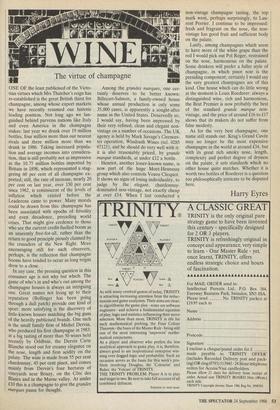The virtue of champagne
ONE OF the least publicised of the Victo- rian virtues which Mrs Thatcher's reign has re-established is the great British thirst for champagne, among whose export markets we have recently resumed our historic leading position. Not long ago we lan- guished behind parvenu nations like Italy and even America in the champagne stakes: last year we drank over 19 million bottles, four million more than our nearest rivals and three million more than we drank in 1986. Taking increased popula- tion and average incomes into considera- tion, that is still probably not as impressive as the 10.75 million bottles imported by Britain in 1898, which represented a stag- gering 60 per cent of all champagne ex- ported; still, the rate of increase, nearly 20 per cent on last year, over 150 per cent since 1982; is reminiscent of the levels of inflation which existed before the Leaderene came to power. Many morals could be drawn from this: champagne has been associated with epochs of frivolity and even decadence, preceding world crises. That might give credence to those who see the current credit-fuelled boom as an unseemly free-for-all, rather than the return to good principle piously claimed by the crusaders of the New Right. More encouraging still for such observers, perhaps, is the reflection that champagne booms have tended to occur as long reigns drew to a close.
In any case, the pressing question in this consumer age is not why but which. The game of who's in and who's out among the champagne houses is always an intriguing one. Great names not living up to their reputation (Bollinger has been going through a dull patch) provide one kind of sport: more satisfying is the discovery of little-known houses matching the big guns of the heavily publicised brands. One such is the small family firm of Michel Dervin, who produced his first champagne in 1983: at a big tasting of more than 50 wines held recently by Oddbins, the Dervin Carte Blanche stood out for creamy elegance on the nose, length and firm acidity on the palate. The wine is made from 55 per cent chardonnay, 45 per cent pinot, and comes mainly from Dervin's four hectares of vineyards near Bouzy, on the Cote des Blanes and in the Marne valley. At under £10 this is a champagne to give the grandes marques pause for thought. Among the grandes marques, one cer- tainly deserves to be better known: Billecart-Salmon, a family-owned house whose annual production is only some 35,000 cases, is apparently a sought-after name in the United States. Deservedly so, I would say, having been impressed by their very refined, clean and elegant non- vintage on a number of occasions. The UK agency is held by Mark Savage's Cirences- ter operation, Windrush Wines (tel. 0285 67121), and he should do very well with it: it is also reasonably priced, by grande marque standards, at under £12 a bottle.
Henriot, another lesser-known name, is now part of the huge Moet-Hennessy group which also controls Veuve Clicquot. It shows no signs of losing individuality, to judge by the elegant, chardonnay- dominated non-vintage, not exactly cheap at over £14. When I last conducted a non-vintage champagne tasting, the top mark went, perhaps surprisingly, to Lau- rent Perrier. I continue to be impressed: fresh and fragrant on the nose, the non- vintage has good fruit and sufficient body on the palate.
Lastly, among champagnes which seem to have more of the white grape than the red I would pick out Pol Roger, restrained on the nose, harmonious on the palate. Some drinkers will prefer a fuller style of champagne, in which pinot noir is the presiding component; certainly I would say the very greatest champagnes are of this kind. One house which can do little wrong at the moment is Louis Roederer: always a distinguished wine, rich and harmonious, the Brut Premier is now probably the best of the standard grande marque non- vintage, and the price of around £16 to £17 shows that its makers do not suffer from false modesty.
As for the very best champagne, one name still stands out. Krug's Grand Cuvee may no longer be the most expensive champagne in the world at around £34, but with its great rich smoky nose, length, complexity and perfect degree of dryness on the palate, it sets standards which no other house quite matches. Whether it is worth two bottles of Roederer is a question too philosophically intricate to be disputed here.
Harry Eyres






























































 Previous page
Previous page